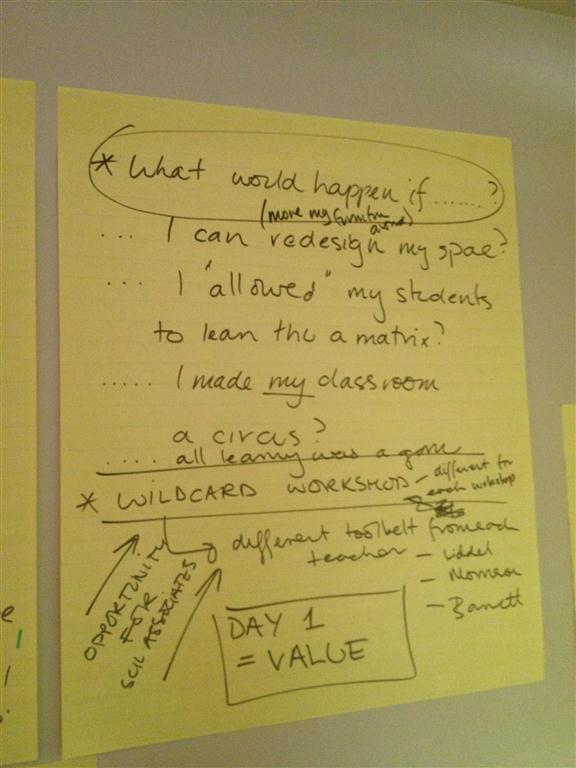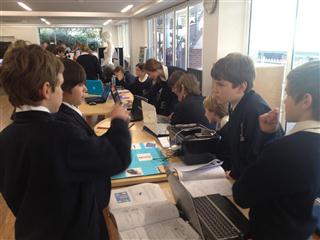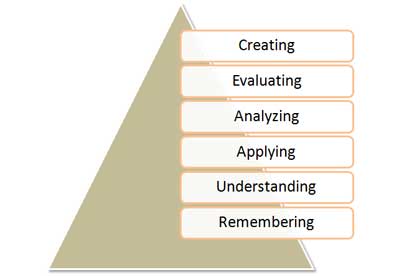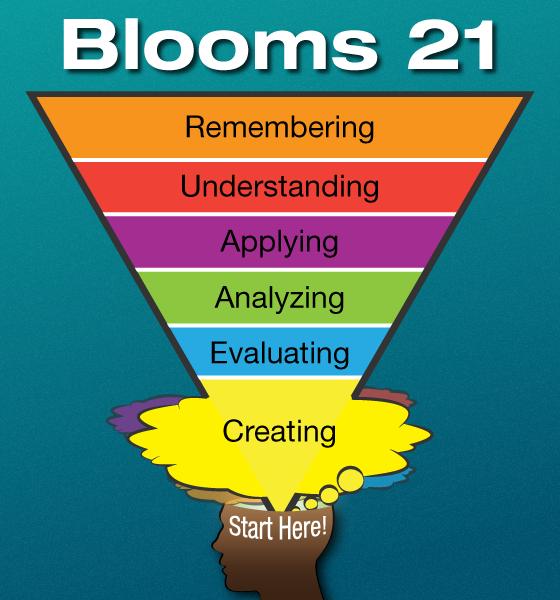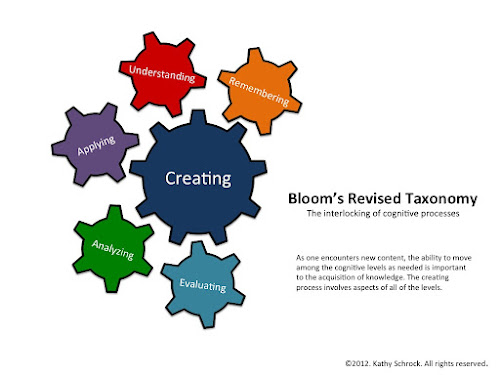This is post #2 on Design. Click here for the back-story.
Click here to read about the end result (an event in Melbourne) that is the culmination of Design for PD.
So, I'm a n00b when it comes to design. The good news is, that providing you're willing to give yourself over to a counter-intuitive process, you can 'get it' and reap some benefits very quickly.
For myself and some colleagues the perfect chance to put the process to the test arose as we sat down to envision a new kind of teacher-PD experience.
You see, we've had, literally, thousands of visitors (about 3k in 3 years) come visit our school. So we asked: "what if we ran our own event, taking to the road for those who can't travel?"
The Core Challenge
We wanted to run a workshoppy, conferencey sort of thing. You can spot the irony and the dilemma immediately: you can't talk about student-centred learning from a microphone. If you had the courage of your own convictions you wouldn't be teacher-talking, now, would you? Whatever we created, it couldn't be microphone-driven! No, no, no!
A Collaborative Alliance
Collaboration is a force-multiplier. I recruited two co-conspirators, Mark Burgess and Lou Deibe. Now, Mark has been practising the design process, and I asked him to lead us through it.
The night before we met, Mark's wife made these posters for us.
We then used these posters to define a kind of test subject. We quickly created 'Meredith', with a full back-story and character profile. The trick is to be really specific and detailed.
So, even as we started defining our challenge, and exploring issues and ideas, Meredith was there with us. Meredith is entirely fictional, but she grounded us, and later we envisaged 'Mel', and could return again to a kind of anchor point: an exercise in empathy to counter our tendencies to get caught up an ego-centric vision reflecting only our own dreams.
Mark guided us through an iterative process where we defined our challenge, researched around the topic, posed questions, and tried to get clarity over what we could really bring to the table.
It became clear to us that we had process to offer, not content. The revolution at NBCS has never been a 'model' per se, it's a process of questioning, reinventing, re-envisioning.
As we wrestled with these questions together, the giant post it notes became a shared thought-space more powerful than any google doc. They're tactile, organic, graphic and transparent.
(Any teacher reading this post: consider covering your walls with butcher's paper and handing out art-liners to the kids. Your physical space will become a giant wiki. The walls will scream "POWER TO THE PEOPLE"; giant table serviettes ready to record the students' insights & ideas and code them onto the building itself.)
You can see the way our three brains engaged collectively, looping out of our skulls and splashing onto the walls thanks to simple pen and paper.
In the video (right), I'm genuinely panicking about the content vs process question.
Lou goes back to our 'Meredith' character (on right of screen) and brings us back to a seductive question: What if...?
This became a winning direction. It allowed us to pitch the whole experience as seduction to get creative.
As the day unfolded, so we slogged a path toward clarity! It was exhilarating, creating something new from a blank slate, bouncing off each other! Collaboration truly is a force-multiplier. It trumps lone-wolf, every time!
Whichever official design 'steps' you follow, the process is iterative, so after we tested our ideas against Meredith's experience, we went to Mel's, and cycled through as time allowed.
All of this took a day, but in my next post I'll document how you use the same process in as little as an hour and still come up trumps with some dynamite outcomes.
Mark, Lou and myself met again for a second block to get the logistical detail down. We came up with such insights and strategies as:
- we won't kick off with a plenary or anyone with a microphone. Instead we'll go straight into experiential, project-based learning, breaking the same script we aspire to break at our school.
- we'll leverage question-walls & google docs for on-the-day collaboration, connection and networking.
- we'll allow / invite teachers to peal-off from the Day 1 learning program as soon as lightning strikes and they have a great idea about what they'd like to try to prototype.
- we'll leverage our conference website to create a kind of on-site flipped-conference, so that teachers who just want to soak up the support materials, templates, scaffolds, etc, in an introverted style are empowered to do so.
If I've intrigued you, pop back to the first post to bounce over to the free online courses that will get you up and running very quickly with a design process.
The End Result: 'Making it Mobile' Event and Metaphor
If you are in Australia, come join us in Melbourne on Sept 13 and 14 - it won't be anesthetising (how's that for a hook!?) and you'll emerge from day 2 with a working prototype, rather than some abstract ideas & a bag full of advertising materials.
The meaning of 'Making it Mobile' is student agency: agency to explore, be curious, to own their own learning, make something authentic and meaningful.
This implies physical mobility, and mobility through the curriculum. Our final three experiential workshops for Day 1 are: the Learning Matrix, Flipped Learning, and Project-Based Learning, each designed to give teachers a scaffolded way forward to up-the-ante toward true student-centric pedagogy. Oh how everyone is talking about it! But let's do it! Let's actually do it!
We're going to repeat the event in Auckland and Christchurch later in 2012 - watch this space!
Next Episode:
Next time, using the design process with 100+ staff, and how no one can run PD from a microphone at our school again!
And finally in Post #4, can 180 Year 5 & 6 students use the design process to create 180 passion projects? (Hint: younglings rarely disappoint when we harness their agenda for learning).
If you keep your ear to the ground, you'll spot a pattern in all this: a reversal of the modern splitting of knowledge into disconnected chunks, in favour of immediate, hands-on, authentic building, making, creating.



